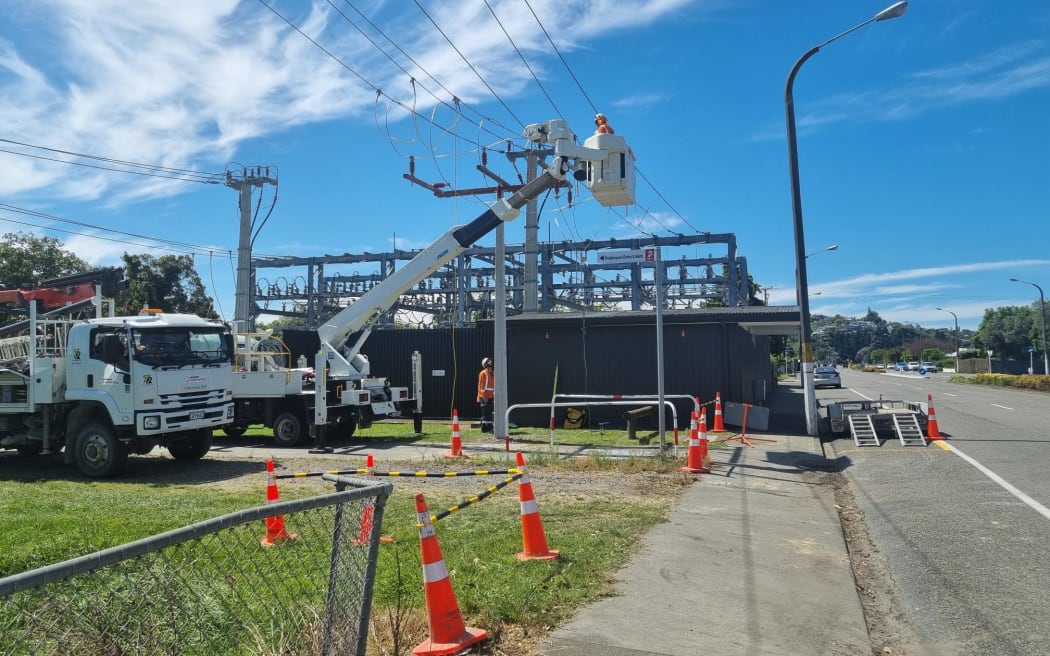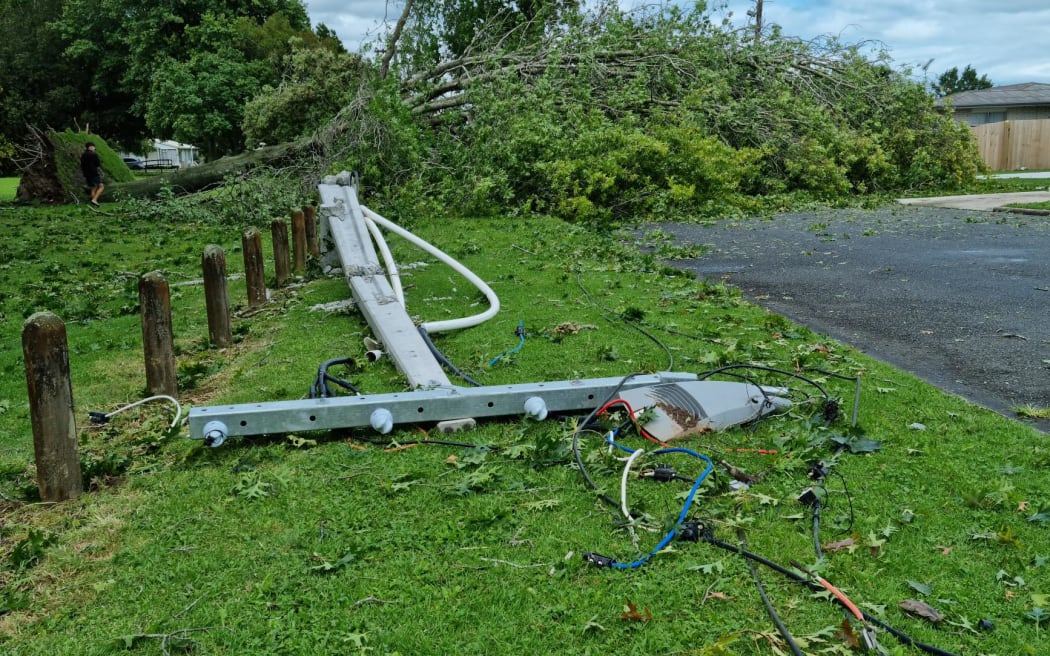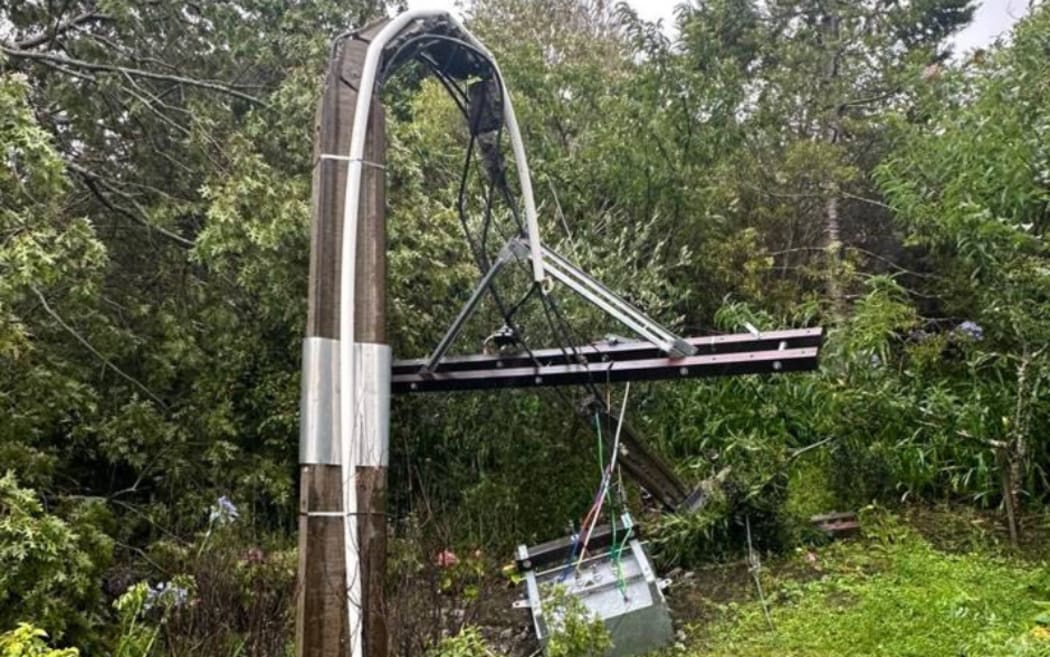
In February, Cyclone Gabrielle left almost 234,000 people without power . Photo: RNZ / Lauren Crimp
Building a more resilient power grid may take a lot of time and money, Transpower says.
This week, the Commerce Commission approved an application from the grid operator to exclude electricity outages caused by Cyclone Gabrielle from its annual performance quality measures.
In February, the cyclone left almost 234,000 people without power throughout New Zealand, with some households completely in the dark for more than a week.
The commission said Transpower demonstrated good industry practice.
"We looked carefully at whether the circumstances and impacts experienced during Cyclone Gabrielle met the threshold and whether they could have been reasonably planned for, prevented or mitigated," commissioner Vhari McWha said.
"Transpower demonstrated good industry practice - and shouldn't be penalised for these interruptions and outages that were beyond its reasonable control."
Transpower chief executive Alison Andrew said building resilience was complex and would not happen overnight.
"It's not always easy, cheap or quick to build additional resilience into infrastructure like the national transmission electricity transmission grid, especially when a lot of it was built 50 years ago or more when we had different understanding of risk.
"We are working closely with central government regulators, stakeholders and local government to carefully design mitigations."

Power lines down in Cambridge, Waikato, in February. Photo: RNZ / Libby Kirkby-McLeod
McWha said the recent extreme weather events have served to reinforce the importance of resilience planning to ensure appropriate investment or mitigation that benefits electricity consumers - while keeping costs reasonable.
Andrew said Transpower had been working on strengthening the grid for a while, but it was never easy to justify the spending.
"When we built the Wairau Road substation in the North Shore in 2013, [it] was a little bit noisy at the time. We had some accusations that we were overspending in resilience.
"But we fought hard for that, and through the Auckland floods the network remained intact, resilient and reliable."
The challenge was how much should the grid operator invest to harden the system, she said.
"How much do we invest in what we call hardened assets that were built to a lower standard previously? And how much work can we invest to make sure we bring our assets up to a sensible level as we work through these risks?"
'We have never been still on this' - Transpower
For the next regulatory period, Transpower asked the Commerce Commission for an additional $200 million to put towards grid resilience in the next five years.
"[The money] is to help us lift and harden up the grid with things like raising equipment, [building] substations to manage for flooding, getting portable equipment, having a portable switch room, mobile equipment to help us recover quickly and it will include new technologies," Andrew said.
"Bearing in mind that when we do rebuild or put new equipment and upgrade our assets, those will be to modern standards, so there is some resilience work going in all the time."
She said the investment would not weigh heavily on ratepayers' pockets.
"At the moment, Transpower represents less than 10 percent of the consumers' bill. [The resilience investment] should not make a big difference on that."
She said Transpower was trying to match resilience with affordability.
"We believe that is an appropriate level of spending to get that balance. But of course, that will be up to the regulator to make a decision on that."
McWha said the commission's upcoming review of Transpower's forecast expenditure for 2025-2030 would be focused on identifying network risks and cost-efficient mitigations.
"We expect Transpower to look hard at resilience planning and its needs now and into the future and put forward a well-justified proposal for us to assess."

A damaged power pole near Warkworth in February. Photo: Supplied / Vector Limited
Times were challenging, Andrew said.
"It's becoming more challenging to manage these extreme weather events. We're very aware of the impact on communities for being without power after Cyclone Gabrielle.
"We're very appreciative to how the community worked with us and other core infrastructure providers."
In March this year, Transpower released a list of 12 substations it had assessed as vulnerable to extreme flooding across New Zealand.
"In addition to those 12, we also at the moment have in-flight work on five other flood substations, whether that's part of an upgrade or our part-proactive targeted resilience work," Andrew said.
"We're also working towards relocating towers where land subsidence has caused risk, we're looking at towers in braided rivers and making sure that we are able to recover well from flood events. We have never been still on this."
'Community wants reassurance' - Napier resident
During Cyclone Gabrielles' devastation, Napier resident Gretta Carney' café was one of the only businesses open while residents faced days without electricity.
"The reason why we were open was because I had invested in a generator, a really good generator the previous year, because I just had a feeling that power wasn't something we could rely on, and that having a generator would be a valuable thing."
She said the community wanted reassurance from electricity suppliers.
"I think people are really happy to support anything that's going to make the future more certain. But at the moment, they don't trust people to deliver that, so rather rely on themselves."
Carney said residents wanted tangible solutions to avoid future power cuts.
"Just handing over more money to some kind of big bucket that was supposed to deliver something, I think people are a bit beyond that, at the moment.
"They want to have tangible outcomes that they can trust, and they want to align themselves in their local communities rather than relying on externalities."
She said a more diverse power system and more local community involvement would bring peace to those who have been affected by the weather.
"I think decentralising the power supply rather than centralising it would be a way to create diversity in the system. That would give more certainty for people that there will be power, because, you know, it's pretty disruptive not having electricity for almost a week."


